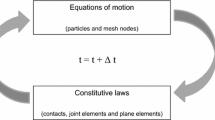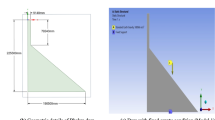Conclusions
-
1.
Analysis of the studies and computations suggests that loss of stability due to shearing is characteristic for concrete gravity dams constructed only on extremely weak rock and semirock foundations. On sound rock and rock of medium soundness, concrete dams form a strong contact with the foundation and lose their stability if there is compressive failure of the foundation with rotation about a pivot center located beneath the foundation surface. Rock foundations for which limiting rotation of the structure is the basic type of failure are characterized by a critical shear coefficient tan ψcr≥1.0#x2013;1.1.
-
2.
It is recommended that gravity dams and their foundations be designed on the basis of two limiting states: on the condition of limiting rotation, which corresponds to the dam's loss of stability and is referred to as the first group of limiting states, and on the condition of incipient rotation for which the local strength of the rock foundation is exceeded; the latter is referred to as the second group of limiting states.
-
3.
The initial stage of rotation (incipient rotation) is accompanied by crack formation in the rock foundation in the region of the upstream face after attaining the ultimate, tensile strength (Rt) with the smallest principal stresses. The final stage of rotation (limiting rotation) is accompanied by failure of the rock mass beneath the downstream face of the structure with the smallest principal stresses that are attained for the ultimate compressive strength (Rc) of the rock mass. It is recommended that the stability and strength of the rock foundations of concrete dams be computed from the conditions of incipient and limiting rotation, using these characteristics of the tensile Rt and compressive Rc strengths of the rock mass, which have a clear-cut physical meaning.
-
4.
Stability computations performed for gravity dams on the basis of the condition of limiting rotation yield safety factors for stability, which correspond, to actual fracture kinematics and are therefore more reliable.
-
5.
Conversion to dam-stability computations based on the conditions of limiting and incipient, rotation make it possible to: a) utilize the additional bearing capacity of sound and medium-sound foundation rocks; b) estblish grounds for economical gravity dams of reduced size, using engineering measures that ensure their adaptability to normal operations as cracks form in the foundation; c) reduce the, depth of the cut formed in rock foundations for dams, assuming that rock characterized by the parameter tan ω≥1.0–1.1 can remain, in the foundation, since in this case loss of stability occurs not as a result of sheart, but due to rotation of the structure, which is characterized by high stability safety factors; d) use engineering methods correctly and efficiently, to increase the stability of dams, such as, for example, their anchorage in the rock foundation, which creates a significant restraining moment that is not considered in computing the shear resistance of the dams.
-
6.
The method proposed to compute the stability and strength of rock foundations of gravity dams can also be expanded to buttress dams and retaining walls.
Similar content being viewed by others
Literature Cited
S.A. Frid, “Stability problems in designing concrete dams,” Proceedings of Lenin Branch of the All-Union Lenin Order S. Ya. Zhuk Scientific-Research Institute for Design and Exploration, No. 5 (1967).
Yu. A. Fishman, “The development of rock mechanics and studies of rock foundations of hydraulic structures in the USSR,” Proceedings of the All-Union Lenin Order S. Ya. Zhuk Scientific-Research Institute for Design and Exploration, No. 33 (1974).
Yu. A. Fishman, “Stress conditions on rock foundations of concrete gravity dams,” Gidrotekh, Stroitel'., No. 3 (1975).
Yu. A. Fishman, Kinematics, of the Failure of a Blocky Rock Foundation in the Shear Process of Concrete Structures, All-Union Conference “Methods of determining the stress state and stability of high-head hydraulic structures,” MISI (1972).
Yu. A. Fishman and E. G. Gaziev, In situ and Model Studies of Rock-Foundation Failure in Concrete-Block Shear Tests. Third Congress of the ISRM, Denver (1974), p. 879–883.
Ya. A. Fishman and E. I. Shirobokov, Effect of the Structure of a Rock Mass on the Character of Its Failure during the Shearing of Footings, Proceedings of the Scientific Symposium “Effect of geologic factors on the properties and state of rock masses,” Collection of papers, Apatity (1975).
H. Link, “The sliding stability of dams,” Water Power,21, Nos. 3, 4, and 5 (1969).
P. D. Evdokimov and R. A. Shiryaev, “Certain rules governing the shear resistance of concrete retaining structures on rock foundations,” Papers to the First International Congress on Rock Mechanics Izd. NIIOSP, (1967).
Yu. A., Fishman Designing Concrete Dams in Combination with the Rock Foundation on the Basis of the Limiting State, Proceedings of Coordinated Conferences on Hydraulic Engineering “The limiting states of concrete and reinforced-concrete designs of hydraulic structures,” No. 99, Énergiya, Moscow (1975).
S. A. Frid and I. A. Baslavskii, Problems Encountered in Computing the Strength of the Contact Layer of Concrete Dams Constructed on Rock Foundations, Proceedings of the All-Union Lenin Order S. Ya. Zhuk Scientific-Research Institute for Design and Exploration, No. 40 (1974).
Additional information
This paper is printed for discussion. Here, as has already been noted in [3], shearing was not considered along weakening surfaces that are critically oriented with respect to a large extension, and on which it is preferred not to construct concrete dams, or where as a last resort, they are strengthened with grout.
Translated from Gidrotekhnicheskoe Stroitel'stvo, No. 5, pp. 17–24, May, 1976.
Rights and permissions
About this article
Cite this article
Fishman, Y.A. Computing the stability and strength of rock foundations under concrete gravity dams. Hydrotechnical Construction 10, 450–461 (1976). https://doi.org/10.1007/BF02399983
Issue Date:
DOI: https://doi.org/10.1007/BF02399983




